火星 ALPO-Japan Latest

Mars Image 2010/05/04(UT)
柚木健吉
Damian Peach,Peter Edwards,Peter Grego,Sadegh ghomizadeh,Carlos.E.Hernandez
D.Peach,P.Edwards,P.Grego,Sadegh.GH,K.Yunoki,Carlos.E
|
Damian Peach (350mm Celestron SCT) |
Fair to good seeing. Weak clouds over Elysium. Brilliant orographics over Tharsis/Olympus Mons.
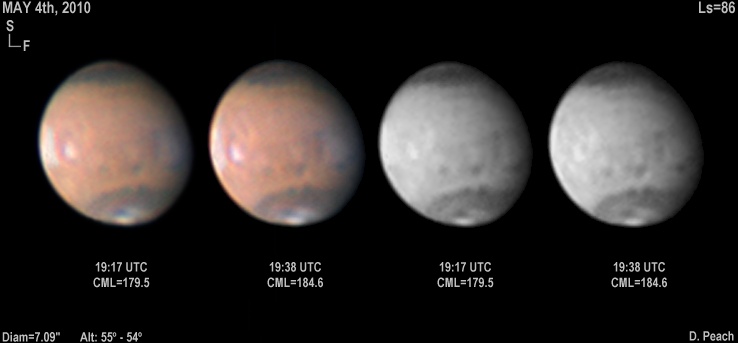

[Damian Peach: Loudwater,Buckinghamshire,United Kingdom]
Here is a late image of Mars,now only 7.1" dia. Blue haze visible on the
terminator as well as bright clouds over the Volcanos (a bit like Earth !)
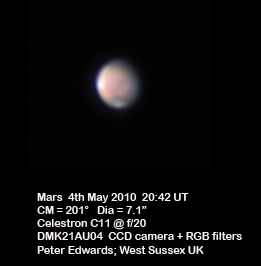 [Peter Edwars: West Sussex United Kingdom]
[Peter Edwars: West Sussex United Kingdom]
2010 May 4
21:05 UT
200mm SCT,250x,integrated light
Seeing: AII-III
Peter Grego (St Dennis,Cornwall,UK)
Central Meridian: 207°
Magnitude: 0.8
Angular diameter: 7”
PA of axis: 359°
Phase: 90%
Notes: This observation is presented with south towards the top.
The north polar cap was bright,noticeably smaller than my last observation several weeks ago,
and it was bordered by a dusky collar,with some extension in the Utopia region.
The terminator was noticeably shaded,and the opposite limb was very bright along its edge.
Several dusky patches were clearly discerned,notably Mare Sirenum and Mare Cimmerium.
Slight subtle shadings suspected elsewhere,but seeing was not very good.
All designations of features are provisional.
 [Peter Grego,Cornwall:UK]
[Peter Grego,Cornwall:UK]
|
Sadegh ghomizadeh (235mm SC) |
seeing was average & atmosphere was very good .
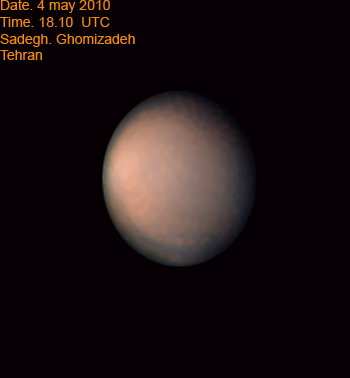 [Sadegh ghomizadeh: Tehran IRAN ]
[Sadegh ghomizadeh: Tehran IRAN ]
|
Kenkichi.Yunoki (260mm Newtonian) |
シーイングが悪く、処理する意欲がそがれる
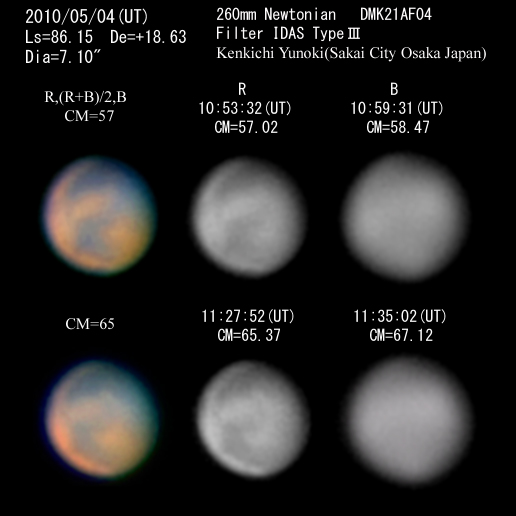
[Kenkichi Yunoki (Sakai City Japan)]
≪大阪府 堺市 柚木健吉≫
|
Carlos E. Hernandez (Drawing:9-inch (23-cm) F/13.5 Maksutov- Cassegrain) |
Thank you for the excellent images of Mars and Saturn throughout the apparition.
They have shown much detail, as always.
I was fortunate to have had a break in my hectic schedule and made an
observation of Mars on May 4, 2010 under very to extremely good seeing
conditions (8-9/10; I was even noting diffraction rings around Mars!). I could
not believe the amount of detail that I detecting over the surface of Mars at
such a relatively small angular diameter but my wife, an experienced observer
herself, was observing with me at the time and was seeing the same features. The
Syrtis Major region appeared to be mottled and complex with alternating light
and dark features. I have not enjoyed such a steady night in a long time. My
Brandon oculars (8 mm and 12 mm) provided very sharp and high contrast views of
Mars.
Date (U.T.): May 4, 2010
Time (U.T.): 02:00-03:00
CM (Degrees West): 286.7-301.3
Ls 86.1*, De 18.2*, Ds 24.7*, p 90%, 7.1”
Magnification: 285x and 388x (Brandon 8 mm and 12 mm)
Filters (Wratten): 30 (Magenta) and 38 (Blue)
Seeing (1-10): 8-9, Antoniadi (I-V): II
02:30 U.T. (CM 294.0*W, Wratten 30 (Magenta)): Syrtis Major appeared dark to
dusky (3-4/10) on the central meridian (CM) and mottled. This complex network of
dark and light features stood out very clearly when the seeing became perfect
(10/10) for brief moments during my observing session. The appearance of this
prominent albedo feature reminded me of the famous observation of Mars made on
September 20, 1909 by the Greco-French astronomer Eugene M. Antoniadi
(1870-1944) in 1909 using the Meudon Observatory 33-inch (84-cm) refractor
(http://www.uapress.arizona.edu/onlinebks/mars/chap09.htm ). I have rarely seen
such detail within this region of Mars even during perihelic apparitions. I have
produced a sectional sketch of the Syrtis Major region below. Hellas appeared
dusky to dull (4-5/10) with thin, bright (7/10) sections within it. Mare
Tyrrhenum was partially obscured by a bright to very bright (7-8/10) haze. The
South Polar Cap (SPC) appeared extremely bright to brilliant (9-10/10) over the
southern limb. The eastern (preceding) portion of Sinus Sabaeus was visible
towards the South-following (Sf) limb. Libya appeared to contain a very bright
(8/10) cloud over it. Utopia/Casius appeared as a dark to dusky wedge towards
the North-preceding (Np) limb. The North Polar Cap (NPC) appeared brilliant
(10/10) towards the northern limb. Aetheria, Isidis Regio, Neith Regio, Meroe
Insula, Aeria, Arabia, Dioscuria,and Eden appeared bright (7/10).
02:45 U.T. (CM 297.6*W, Wratten 38 (Blue)): Syrtis Major appeared dull (5/10)
beneath a bright (7/10) haze. Southern maria was also vaguely visible beneath a
bright (7/10) haze. Very bright to extremely bright (8-9/10) evening (preceding)
and morning (following) limb hazes are visible. The South Polar Cap (SPC) and
the North Polar Cap (NPC) were both extremely bright to brilliant (9-10/10).
I have also attached a sectional sketch of the Syrtis Major region which
displayed mottling, especially during the best moments of seeing.
The best of luck to you, your family, and the members of ALPO Japan. May you
have clear and steady skies.
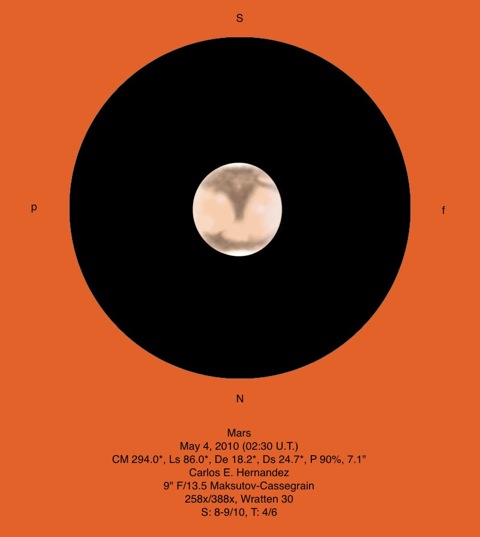

 [Carlos.E. Hernandez South Florida U.S.A ]
[Carlos.E. Hernandez South Florida U.S.A ]




[Peter Edwars: West Sussex United Kingdom]
[Peter Grego,Cornwall:UK]
[Sadegh ghomizadeh: Tehran IRAN ]



[Carlos.E. Hernandez South Florida U.S.A ]
 ALPO-Japan Latest
ALPO-Japan Latest

 Mars Section
Mars Section